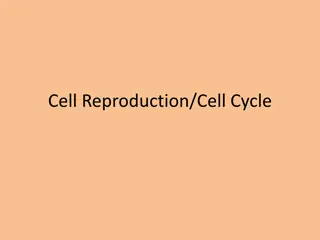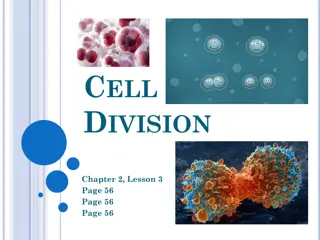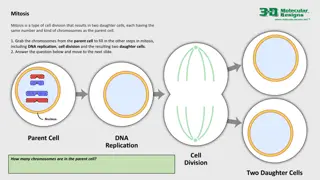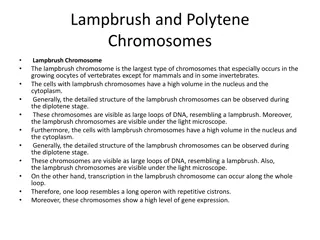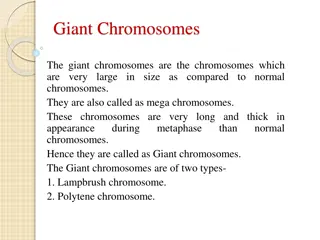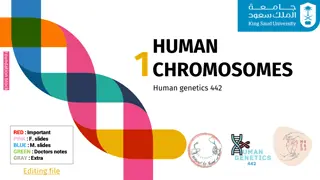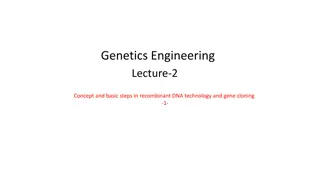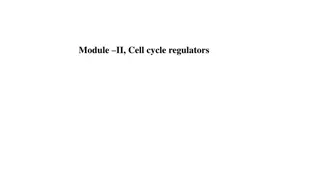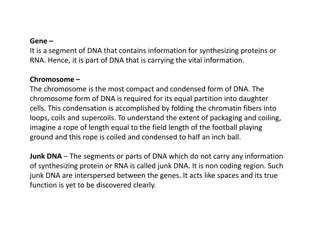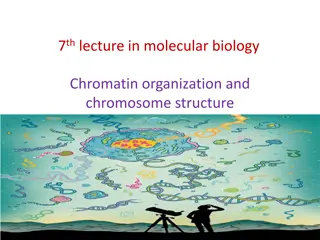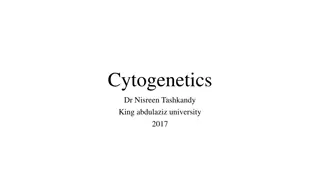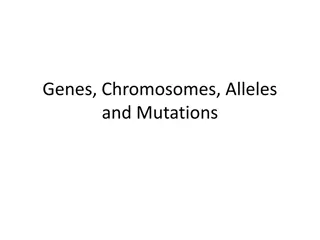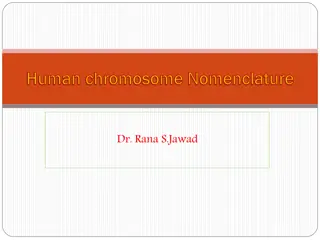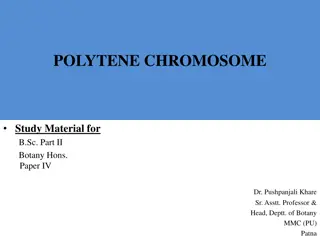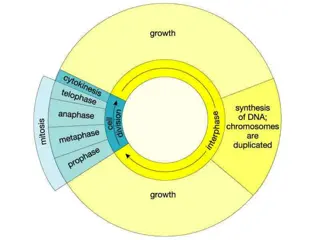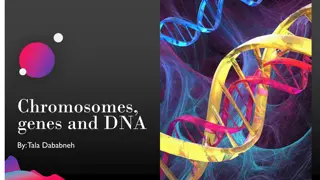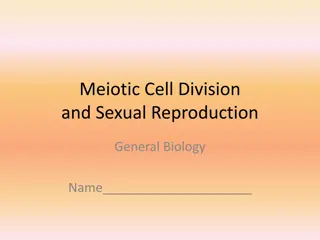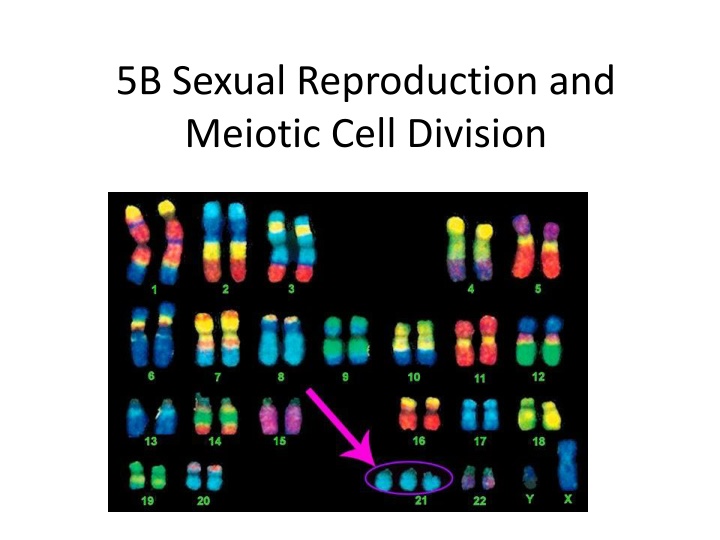
Chromosomes and Cell Division
In sexual reproduction, chromosomes play a crucial role in genetic inheritance. Eukaryotic chromosomes condense to form chromatin which further compacts into chromosomes before cell division. Understanding chromosome structure, homologous pairs, diploid and haploid cells, and human chromosome number is essential for comprehending genetic diversity and inheritance. The images provide visual aid in grasping these concepts.
Download Presentation

Please find below an Image/Link to download the presentation.
The content on the website is provided AS IS for your information and personal use only. It may not be sold, licensed, or shared on other websites without obtaining consent from the author. If you encounter any issues during the download, it is possible that the publisher has removed the file from their server.
You are allowed to download the files provided on this website for personal or commercial use, subject to the condition that they are used lawfully. All files are the property of their respective owners.
The content on the website is provided AS IS for your information and personal use only. It may not be sold, licensed, or shared on other websites without obtaining consent from the author.
E N D
Presentation Transcript
5B Sexual Reproduction and Meiotic Cell Division
Eukaryotic Chromosomes DNA binds to proteins called histones DNA and histones condense to form chromatin
Eukaryotic Chromosomes (cont.) Chromatin is condensed completely to form chromosomes after the DNA has replicated and the cell is ready for division. Chromosomes make it possible to separate DNA precisely during cell division.
Chromosomes can be seen in two forms: 1. Single-Arm: are composed of a single chromatid 2. Double- Arm (Replicated Form, Duplicated form):are made up of paired, genetically identical chromatids, called sister chromatids. Sister chromatids are joined at the centromere. Because the sister chromatids are formed during replication of DNA, they are identical right down to the nucleotide sequences!
Chromosome Number Organisms have 2 sets of chromosomes: One set from the female parent One set from the male parent Example: The fruit fly (Drosophila) 8 chromosomes total How many from mom? How many from dad? The corresponding chromosomes from mom and dad are called homologous.
Homologous Chromosomes same size same centromere position same banding pattern same genes in the same locations on each pair BUT, the nucleotide sequences at the same gene location may or may not be the same
Diploid and Haploid Diploid- cells containing both homologous chromosomes Diploid number of chromosomes is represent by 2N where N is the number of chromosomes in a single set Example: Drosophila have 8 total chromosomes so 2N=8 (N= ______) Haploid- cells containing just one set of chromosomes Gametes are haploid N Example: In Drosophila, N = _______ Diploid or Haploid?
Human Chromosome Number Humans have 23 pairs of chromosomes for a total of 46. 1 of each pair came from mom, and 1 of each pair came from dad A Karyotype shows a complete diploid set of chromosomes, grouped in pairs, arranged in size order.
Somatic Cells and Sex Cells Somatic cells- body cells which contain all of the chromosomes. Sex cells (gametes)- sperm and egg cell which contain half the number of chromosomes. One of each sex cell is needed during sexual reproduction to produce an offspring
Reproduction Reproduction- the making of new individuals Asexual Reproduction- Requires only one parent cell Offspring are genetically identical to the parent
Sexual Reproduction Involves fusion of two separate parent cells Genetic information is inherited from both parents Most animals and plants reproduce this way 9_sex_cells
Comparing Asexual and Sexual Reproduction Species survive by reproduction Species better suited to their environment survive better, and reproduce more, passing on their genes Asexual Reproduction: Fast! - All organisms identical. - This is an advantage if conditions are favorable and a disadvantage of they are not. Sexual Reproduction: Requires more time - Provides genetic diversity because DNA comes from both parent cells - Advantageous in varying environments.
Asexual Sexual Number of Parents Are sex cells needed? (yes/no) Genetic Variability of Offspring (high/low) Advantage in what kind of environment? (Changing/non- changing)
Mitosis vs. Meiosis Mitosis a step in cell division in which the nucleus divides into two, genetically identical nuclei - Occurs during asexual reproduction, growth and repair of cells (somatic cells) Meiosis division of nuclear material that produces sex cells (egg & sperm) with half the number of chromosomes - Occurs during sexual reproduction to make sex cells
Review of Mitosis Interphase G1, S, G2 Mitosis PMAT Cytokinesis
Meiosis The process of producing gametes (sex cells) In this process the number of chromosomes is cut in half Why is it important for gametes to have only half the number of chromosomes?
Mitosis Mitosis Fertilization Mitosis + =
Meiosis Meiosis only occurs in cells that will produce sex cells In mammals, these cells are located in the ovary or the testes The rest of the body cells that make up an organism divide normally by mitosis
Meiosis Involves 2 Separate Divisions 1. Meiosis I: Similar to Mitosis A. During S-phase of Interphase I the chromosomes duplicate B. During Prophase I, the homologous chromosomes pair up into tetrads C. Crossing over (the exchange of parts of the homologous chromosomes) occurs at this time What will crossing over do to the daughter cells that will be produced?
homologous pair before crossing-over homologous pair after crossing-over
Metaphase, Anaphase, Telophase, Cytokinesis (I) These stages occur the same way they occur in Mitosis except in Meiosis I, the homologous chromosomes separate and end up in different cells (segregated) Metaphase I Anaphase I Telophase I and Cytokinesis I
RULE OF INDEPENDENT ASSORTMENT Homologs (chromosomes that are homologous to each other) move in a random fashion to either end of the cell. The two resulting cells end up with a random assortment of the mother and father s chromosomes.
How are the daughter cells resulting from meiosis I different from their parent cell? Genes have been recombined by crossing over Each daughter may have some chromosomes from mom and some from dad (independent assortment) The resulting cells have a haploid # of double armed chromosomes.
The Second Meiotic Division 2. Meiosis II: The division of the daughter cells made in meiosis I - Unlike the first division, chromosomes are NOT replicated during Interphase II - Prophase II- no tetrads form because homologous chromosomes have already been separated
Metaphase, Anaphase, Telophase, Cytokinesis (II) Similar to the stages of Meiosis I, only sister chromatids are separated this time This gives each daughter only half the chromosomes of the original parent cell 4 daughters are produced The daughters have a haploid number of single armed chromosomes Metaphase II Anaphase II Telophase II and Cytokinesis II
The products of Meiosis The female gamete = egg cell The male gamete = sperm cell Each is Haploid (has the normal # of chromosomes) During fertilization, egg and sperm randomly combine making a Diploid zygote The zygote grows into an organism through Mitosis
Sources of Genetic Variation in Offspring 1. Crossing over 2. Independent Assortment 3. Random combination of sperm and egg. These all contribute to why siblings are all different despite having the same parents!
Summary Meiosis I-First division diploid number of double-arm chromosomes is reduced to a haploid number of double-arm chromosomes Meiosis II- Second division haploid number of double-arm chromosomes is divided to produce cells with a haploid number of single- arm chromosomes
Why do you think Meiosis is called a reductiondivision process?
Egg and Sperm Production GAMETOGENESIS- the production of gametes. The process is slightly different in males and females 1. Oogenesis- production of eggs 2. Spermatogenesis- production of sperm
1. Oogenesis In the ovaries of the female Produces one egg for every parent cell Occurs in human females during embryonic development and continues until menopause. Note that the cytoplasm is NOT equally divided between the eggs during this process. The result is one large, functional egg with a better chance of survival.
2. Spermatogenesis in the male testes produces 4 viable (functioning) sperm for every beginning cell
Chromosomal Disorders Occur mainly due to errors in meiosis (rare) Nondisjunction- when homologous chromosomes fail to separate during meiosis I Or when sister chromatids fail to separate during meiosis II Gametes will be made with the wrong number of chromosomes
Example An extra chromosome in a gamete will lead to an offspring with 3 copies of one chromosome This is called trisomy The most common form of trisomy involves chromosome 21 Three copies of chromosome 21 leads to downs syndrome
Other Chromosomal Disorders Chromosome Affected Is nondisjunction Involved? Symptoms Other interesting details? Turner s Syndrome Jacob s Syndrome Klinefelter Syndrome Edward s Syndrome Cri-du-chat Metafemale
MITOSIS MEIOSIS Kinds of Cells Produced Number of Cells Produced Chromosome # of parent cell during asexual reproduction. Chromosome # of daughter cells Number of times DNA is replicated Number of cell divisions 1) To form new cells during To form gametes for sexual Function growth or to repair damaged reproduction cells. 2) To produce a new organism during asexual reproduction


